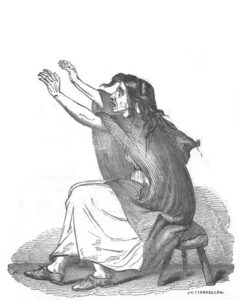Keening: “To Publicly Display, Articulate & Channel the Grief of a Community”

Among the phrases I hear most often in my work as a funeral celebrant is, “I don’t want anyone to be sad.” Among the most common sounds at a burial service: silence. Only rarely do I hear the bereaved cry out.
“Grief has become private, to be contained, controlled,” says Irish broadcaster Marie-Louise Muir in her BBC Radio documentary, Songs for the Dead, reflecting that her own daughters had never been to a wake, once considered the most Irish of traditions. “How very different in the time of keening, when women were paid to cry, sing, and wail over the dead, to publicly display, articulate, and channel the grief of a whole community.”
The documentary and a related article explore the reasons behind the death of keening in Ireland – and the consequences of having discarded this way of mourning.
“It was pretty much outlawed in Ireland,” says Muir. “It came up against the Catholic Church….When the body was laid out for the wake, the priest would come in and say prayers over it….Then, can you imagine the awkwardness of the keener coming in and the… priest having to give way to this… pagan custom?” By that time, Irish keeners were aways women, a further threat to the authority of the Church. But “it wasn’t just the Catholic Church saying ‘No’,” Muir says. During the Victorian era of the Grand Tour, keeners at Irish funerals became a spectacle among world travelers seeking the primitive and exotic. The “performing monkey element… was difficult for the people themselves. They felt they were being viewed as being almost backward. They wanted to be part of the modern, forward-looking world.”
But the decline of keening in Ireland was noted as early as 1833, in an article in the Dublin Penny Journal. The Irish Funeral Cry: The Ullaloo, Keeners and Keening found that keening “has fallen greatly into disuse, and is now of rare occurrence, except in some very few old families, and among the peasantry, and with them it has now generally degenerated into a mere cry of an extremely wild and mournful character, which however, consisting of several notes, forming a very harmonious musical passage, approaches to a species of song, but is almost always destitute of words.”
This early 19th century account of keening traces the Irish custom to “the Celtic ancestors, the primaeval inhabitants of this isle.” Before them, though, “it was known to the Greeks and Romans, who, however, seem to have borrowed it from the Eastern nations, among whom probably it had its origin; and from the Scriptures we learn that it was practised among the Israelites.” A traveller’s letter written in 1712 observes that “the Shilhenses have the same custom as the Arabs, the Jews, and the Irish, of lamenting over the dead, uttering various cries of grief, tearing their hair, and asking the deceased why did he die? why did he leave them?”
“In ancient times,” the Dublin Penny article tells us, “it was the duty of the bard, who was attached to the family of each chief or noble, assisted by some of the household, to raise the funeral song.” A 12th century account describes the bards “dividing the mourners into two bodies, each alternately singing their part, and the whole at times, joining in full chorus” around the head and the foot of the body which was “dressed in grave clothes, and ornamented with flowers, … placed on a bier, or some elevated spot….Thus alternately, were the song and the choruses performed during the night. The genealogy, rank, possessions, the virtues and vices of the dead were rehearsed, and a number of interrogations were addressed to the deceased: as, why did he die?”
In this modern era of both death denial and “death acceptance” and “death positivity,” is there room for the grief of those left behind?
“We should be allowed to lament,” says one voice in the documentary. “Maybe less of us would be going to the GP for anti-depressants.”
Read about “An Occupation of Loss,” a performance piece by the artist Taryn Simon, in which professional mourners from 15 countries – some of which have banned the practice – sat in a half circle of 11 concrete towers at an armory in New York City last fall: coverage in The Vulture and The New Yorker.
Read Breaking the Silence, my own account of encountering, and voicing, the sound in a community grief ritual lead by Sobonfu Somé, whose death earlier this year is being mourned by the many she helped around the world.


Wonderful article. I always wondered why we don’t see more visible displays of grief and grieving in our western culture.
Thanks for sharing your perspective, Susan. It’s been so useful for me to study with Stephen Jenkinson who encourages more of us to ask the question you pose: What happened to a people such that [insert current circumstances here, e.g. silence in the face of grief] looks like a good idea?